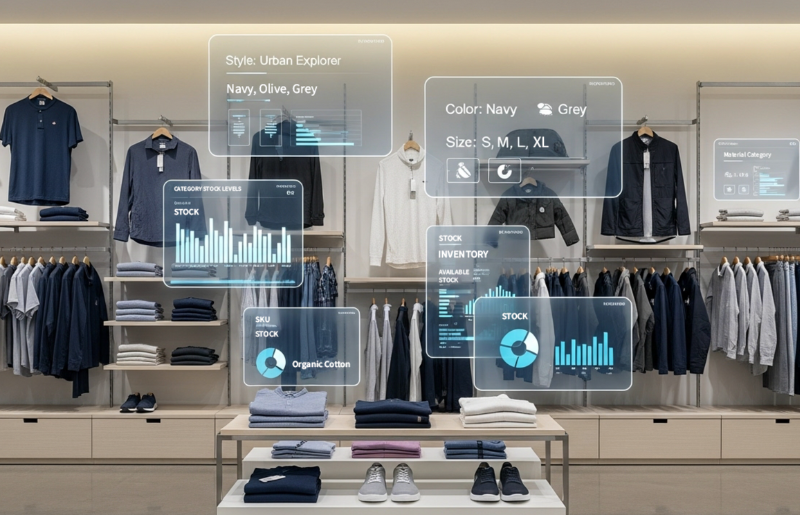
In the retail industry, AI is now powering decisions once driven solely by instinct, particularly in the area of retail merchandising. Research Gate recently reported that AI-based assortment planning has helped some retailers cut SKUs by 22% while increasing sales by 15%. Through predictive AI, machine learning and real-time data processing, retailers are able to forecast demand with unprecedented accuracy, optimize product assortments and respond instantly to real-time market signals—managing inventory with surgical precision and growing sales by anticipating customer demand at scale.
The Power of AI, Turning Data Into Intelligence
AI’s ability to synthesize vast, multi-source data in real time to generate granular, predictive insights exceeds human capacity, transforming how decisions are made across complex environments and millions of data points.
Going beyond traditional number-crunching, AI-powered retail planning systems act as the engine behind data-driven merchandising strategies. They continuously synthesize inputs from sales history, online browsing patterns, social media sentiment and regional buying behaviors, creating hyper-granular recommendations tailored to every SKU, store and channel. These systems report what’s happening and predict what’s likely to happen next, enabling planners to adjust and optimize in real time, matching localized demand and responding to sudden market opportunities or disruptions.
When this analytical precision is paired with the nuanced judgment of experienced merchandisers, the powerful synergy ensures that strategy is both analytically sound and emotionally resonant, aligning commercial performance with authentic brand storytelling. AI optimizes retail operations and elevates them. At 7thonline, the philosophy has always been clear: AI is a force multiplier for human expertise, not a replacement for it. We build AI to deliver the art of merchandising at scale.

The Human + AI Model: Retail’s Competitive Edge
AI’s unmatched accuracy and speed give retailers a powerful decision-making engine, realized in lockstep with seasoned merchandising instinct. AI can identify the most statistically profitable product mix, but it takes human insight to interpret those findings through the lens of brand vision, trend trajectory and customer psychology. Together, they create a merchandising approach that is not only faster and more accurate, but also deeply attuned to the creative and emotional cues that drive fashion purchasing. From demand forecasting to in-season adjustments, AI is turning vast streams of raw data into actionable intelligence that directly improves both profitability and customer experience.
Algorithms excel at detecting patterns in customer behavior and past performance; human judgment applies brand DNA, storytelling and creative intuition to curate assortments that connect with shoppers on a deeper level. The planner who detects the start of a microtrend, the designer who senses a shift in aesthetic and the strategist who understands the subtleties of local customer behavior provide the interpretive lens that gives AI insights their commercial and emotional impact.
In fashion merchandising, this blend of science and art is critical. Many merchandisers have honed their craft over decades, learning how to anticipate what shoppers will want before they know it themselves. This involves not just picking the right styles, colors and sizes, but timing them perfectly for the market and presenting them in ways that evoke desire; processes that would have taken an insurmountable amount of time are now instantaneous. By embedding AI into this process, retailers ensure that the brand’s vision is brought to life with precision while creating assortments that resonate not only with a demographic profile, but with the communities they serve.
In practice, this human-AI partnership doesn’t follow a single formula. It adapts to each retailer’s goals, product categories and market dynamics. The most effective applications are those where AI’s scale and speed are paired with the merchandiser’s ability to recognize nuance and context that algorithms can’t fully capture.

Use Case Scenarios: Blending AI Precision with Retail Merchandising Intuition
The balance between human expertise and AI intelligence is most visible in three critical areas: assortment planning, dynamic replenishment and trend forecasting. Each demonstrates how technology and creativity converge to deliver sharper, more profitable decisions.
Assortment Planning
AI-powered assortment tools analyze SKU performance, customer demographics and emerging trend signals to recommend the most profitable product mix for each store or channel. Merchandisers then refine these recommendations, filtering them through brand identity and their understanding of customer sentiment to ensure the selection aligns with both commercial goals and the brand’s creative vision.
Dynamic Replenishment
Predictive analytics and real-time sales monitoring allow retailers to make replenishment decisions based on precise demand forecasts. Merchandisers add value by incorporating context outside of historical data including sudden weather shifts, influencer-driven demand spikes or marketing campaigns, making decisions that respond to both the numbers and the moment.
Trend Forecasting
AI scans massive volumes of data from social media, search trends and global sales to detect early signals of what’s gaining traction. Merchandisers interpret these patterns through the brand’s unique perspective, deciding which trends to lean into, adapt or pass on entirely, ensuring that what makes it to market is both timely and authentic.
Across each of these use cases, AI delivers the analytical horsepower, and human expertise ensures those insights are translated into actions that not only improve margins but also strengthen the emotional connection between brand and customer.
AI is a necessity in its ability to derive detailed, data-rich insights at both scale and depth that is fundamentally transforming how decisions are made. What once relied on gut instinct and reactive planning is now informed by predictive models, volumes of real-time data and adaptive machine learning algorithms that uncover patterns invisible to the human eye; AI enables retailers to operate with a level of precision, speed and contextual awareness that was previously unattainable.
As retail continues to evolve, those who embrace this human-plus-AI model will unlock a new era of intelligence-driven merchandising—where data doesn’t just inform decisions, it transforms possibilities.




